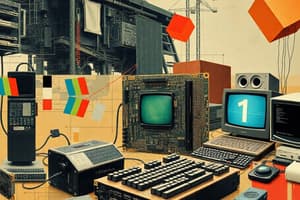Podcast
Questions and Answers
What is the primary function of the Central Processing Unit (CPU) in a computer?
What is the primary function of the Central Processing Unit (CPU) in a computer?
- Executes instructions and performs calculations (correct)
- Temporary storage for data and program instructions
- Communication pathway for data transfer between components
- Allow users to interact with the computer
Which architecture uses separate buses for data and instructions?
Which architecture uses separate buses for data and instructions?
- CISC Architecture
- RISC Architecture
- Von Neumann Architecture
- Harvard Architecture (correct)
What is the purpose of cache memory in a computer?
What is the purpose of cache memory in a computer?
- Permanent storage for data and program instructions
- Communication pathway for data transfer between components
- Small, fast memory for frequently accessed data (correct)
- Temporary storage for data and program instructions
What is the unit of measurement for clock speed?
What is the unit of measurement for clock speed?
What is the benefit of multithreading in computer architecture?
What is the benefit of multithreading in computer architecture?
What is the purpose of virtual memory in a computer?
What is the purpose of virtual memory in a computer?
Flashcards are hidden until you start studying
Study Notes
Computer Architecture
Definition: Computer Architecture refers to the design and organization of a computer's internal components, including the way they interact to perform tasks.
Key Components:
- Central Processing Unit (CPU): Executes instructions and performs calculations
- Memory (RAM): Temporary storage for data and program instructions
- Input/Output (I/O) Devices: Allow users to interact with the computer
- Bus: A communication pathway for data transfer between components
CPU Architecture:
- Von Neumann Architecture: Most common architecture, uses a single bus for data and instructions
- Harvard Architecture: Separate buses for data and instructions, faster performance
- RISC (Reduced Instruction Set Computing): Simplified instruction set, improved performance and power efficiency
- CISC (Complex Instruction Set Computing): More complex instructions, better code density
Memory Hierarchy:
- Main Memory (RAM): Volatile, temporary storage
- Cache Memory: Small, fast memory for frequently accessed data
- Virtual Memory: Combination of RAM and disk storage for efficient memory use
Performance Metrics:
- Clock Speed (GHz): Measures CPU processing speed
- Instructions Per Clock (IPC): Measures CPU efficiency
- ** MIPS (Millions of Instructions Per Second)**: Measures CPU performance
Parallelism:
- Multithreading: Multiple threads share CPU resources
- Multiprocessing: Multiple CPUs or cores for improved performance
- Distributed Computing: Multiple computers work together on a task
Computer Architecture
- Refers to the design and organization of a computer's internal components, including the way they interact to perform tasks.
Key Components
- The Central Processing Unit (CPU) executes instructions and performs calculations.
- Memory (RAM) provides temporary storage for data and program instructions.
- Input/Output (I/O) Devices allow users to interact with the computer.
- The Bus is a communication pathway for data transfer between components.
CPU Architecture
Von Neumann vs. Harvard Architecture
- The Von Neumann Architecture is the most common architecture, using a single bus for data and instructions.
- The Harvard Architecture uses separate buses for data and instructions, resulting in faster performance.
RISC vs. CISC
- RISC (Reduced Instruction Set Computing) uses a simplified instruction set, resulting in improved performance and power efficiency.
- CISC (Complex Instruction Set Computing) uses more complex instructions, resulting in better code density.
Memory Hierarchy
- Main Memory (RAM) is volatile, temporary storage.
- Cache Memory is a small, fast memory for frequently accessed data.
- Virtual Memory is a combination of RAM and disk storage for efficient memory use.
Performance Metrics
- Clock Speed (GHz) measures CPU processing speed.
- Instructions Per Clock (IPC) measures CPU efficiency.
- MIPS (Millions of Instructions Per Second) measures CPU performance.
Parallelism
- Multithreading allows multiple threads to share CPU resources.
- Multiprocessing uses multiple CPUs or cores for improved performance.
- Distributed Computing involves multiple computers working together on a task.
Studying That Suits You
Use AI to generate personalized quizzes and flashcards to suit your learning preferences.




